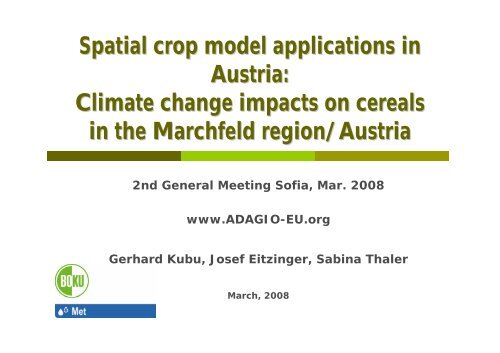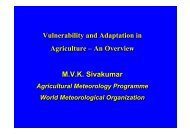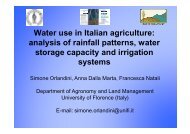Spatial crop model applications in Austria: Climate change ... - adagio
Spatial crop model applications in Austria: Climate change ... - adagio
Spatial crop model applications in Austria: Climate change ... - adagio
Create successful ePaper yourself
Turn your PDF publications into a flip-book with our unique Google optimized e-Paper software.
<strong>Spatial</strong> <strong>crop</strong> <strong>model</strong> <strong>applications</strong> <strong>in</strong><br />
<strong>Austria</strong>:<br />
<strong>Climate</strong> <strong>change</strong> impacts on cereals<br />
<strong>in</strong> the Marchfeld region/<strong>Austria</strong><br />
2nd General Meet<strong>in</strong>g Sofia, Mar. 2008<br />
www.ADAGIO-EU.org<br />
Gerhard Kubu, Josef Eitz<strong>in</strong>ger, Sab<strong>in</strong>a Thaler<br />
March, 2008
Investigation area: area:<br />
Marchfeld
Crop Models<br />
Carbon<br />
Water<br />
Nitrogen
DSSAT v 4<br />
(Decision Support System for Agrotechnology Transfer)
Soil classes<br />
Available water capacity of soils<br />
the range of available<br />
water that can be stored<br />
<strong>in</strong> soil (1 m depth) and<br />
be available for grow<strong>in</strong>g<br />
<strong>crop</strong>s
Soil classes<br />
examples<br />
Parachernosem<br />
Chernosem and colluvial<br />
Fluvisols<br />
Chernosem<br />
1 2 3 4 5<br />
awc 300 [mm]<br />
area: 2% 15% 61% 22% 0.2%<br />
Source: eBOD - Die digitale Bodenkarte, BFW, 2005
Calibration:<br />
Calibration:<br />
W<strong>in</strong>ter wheat and spr<strong>in</strong>g barley<br />
Yield [kg ha -1 ]<br />
W<strong>in</strong>ter wheat: 16 calibration years Spr<strong>in</strong>g barley: 8 calibration years<br />
Federal experimental as well as weather station: Fuchsenbigl<br />
(lat 48.322, long 17.000, elevation 149 m)
<strong>Climate</strong> <strong>change</strong> impacts - methodology<br />
multi-year simulation is made to assess mean and variability<br />
Source: Dubrovsky M.,2004; Met&Roll: http://www.ufa.cas.cz/dub/impacts/met&roll.htm
Sow<strong>in</strong>g date<br />
<strong>change</strong>s <strong>in</strong> respect to the present conditions – <strong>in</strong> days<br />
� W<strong>in</strong>ter wheat: delay of the average sow<strong>in</strong>g date<br />
<strong>in</strong> autumn<br />
14<br />
12<br />
10<br />
8<br />
6<br />
4<br />
2<br />
0<br />
0<br />
-2<br />
-4<br />
-6<br />
-8<br />
-10<br />
HadCM high HadCM low CSIRO high CSIRO low ECHAM high ECHAM low<br />
� Spr<strong>in</strong>g barley: earlier average sow<strong>in</strong>g date <strong>in</strong> spr<strong>in</strong>g<br />
HadCM high HadCM low CSIRO high CSIRO low ECHAM high ECHAM low
A2 SRES scenario 2050 - W<strong>in</strong>ter wheat Yield<br />
% <strong>change</strong> <strong>in</strong> respect to the present conditions
Water stress <strong>in</strong>dex: <strong>in</strong>dex<br />
Water factor for growth - Spr<strong>in</strong>g barley<br />
2050
Conclusion:<br />
Conclusion<br />
� spr<strong>in</strong>g barley showed more sensitivity to<br />
climate <strong>change</strong> than w<strong>in</strong>ter wheat<br />
� Yield potential of w<strong>in</strong>ter wheat <strong>in</strong>creases<br />
� especially due to the CO 2 -fertiliz<strong>in</strong>g effects<br />
� it can also profit by higher w<strong>in</strong>ter precipitation<br />
� For spr<strong>in</strong>g barley <strong>in</strong>creased aridity leads to<br />
a decrease of the yield potential or to<br />
stagnation
ADAGIO – General<br />
Meet<strong>in</strong>g Sofia<br />
www.ADAGIO-EU.org<br />
www.ADAGIO EU.org<br />
Thank you<br />
for your attention! attention<br />
Gerhard Kubu – gerhard.kubu@boku.ac.at – BOKU Vienna, <strong>Austria</strong>





![Irrigation Water Use Efficiency IWUE [ kg/mm ] - adagio](https://img.yumpu.com/42584177/1/190x134/irrigation-water-use-efficiency-iwue-kg-mm-adagio.jpg?quality=85)



